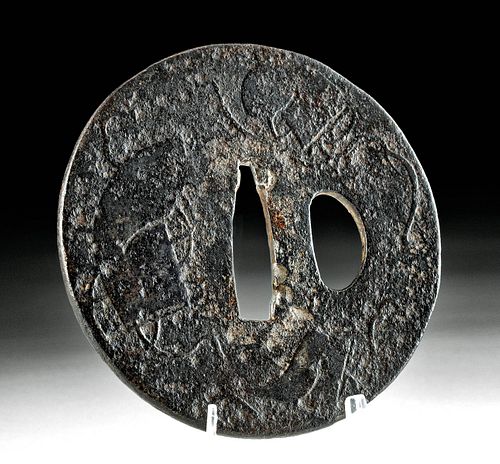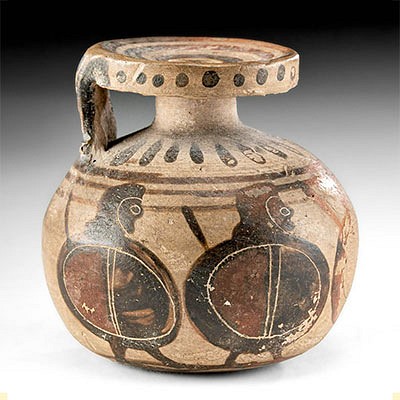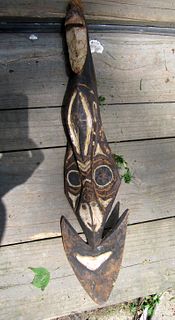Japanese Edo Iron Tsuba
Lot 46b
About Seller
Artemis Fine Arts
686 S Taylor Ave, Ste 106
Louisville, CO 80027
United States
Selling antiquities, ancient and ethnographic art online since 1993, Artemis Gallery specializes in Classical Antiquities (Egyptian, Greek, Roman, Near Eastern), Asian, Pre-Columbian, African / Tribal / Oceanographic art. Our extensive inventory includes pottery, stone, metal, wood, glass and textil...Read more
Categories
Estimate:
$400 - $600
Absentee vs Live bid
Two ways to bid:
- Leave a max absentee bid and the platform will bid on your behalf up to your maximum bid during the live auction.
- Bid live during the auction and your bids will be submitted real-time to the auctioneer.
Bid Increments
| Price | Bid Increment |
|---|---|
| $0 | $25 |
| $300 | $50 |
| $1,000 | $100 |
| $2,000 | $250 |
| $5,000 | $500 |
| $10,000 | $1,000 |
| $20,000 | $2,500 |
| $50,000 | $5,000 |
| $100,000 | $10,000 |
| $200,000 | $20,000 |
About Auction
By Artemis Fine Arts
Jan 7, 2021
Set Reminder
2021-01-07 10:00:00
2021-01-07 10:00:00
America/New_York
Bidsquare
Bidsquare : Ancient / Ethnographic Art Through The Ages
https://www.bidsquare.com/auctions/artemis-gallery/ancient-ethnographic-art-through-the-ages-6258
Ancient art from Egypt, Greece, Italy and the Near East, as well as Asian, Fossils, Pre-Columbian, Native American, African / Tribal / Oceanic, Fine art, and much more! All categories, all price ranges... all legally acquired and guaranteed to be as described or your money back. Artemis Fine Arts info@artemisfinearts.com
Ancient art from Egypt, Greece, Italy and the Near East, as well as Asian, Fossils, Pre-Columbian, Native American, African / Tribal / Oceanic, Fine art, and much more! All categories, all price ranges... all legally acquired and guaranteed to be as described or your money back. Artemis Fine Arts info@artemisfinearts.com
- Lot Description
East Asia, Japan, Edo Period, ca. later 18th to early 19th century CE. A fabulous forged-iron maru-gata (round) tsuba, a disc-shaped hand guard traditionally employed on Japanese swords. There is a decorative opening to one side of the Nakago-ana (central blade opening), and upon close examination one can see that the surfaces were embellished with organic and figural motifs. Size: 3" W (7.6 cm)
A tsuba is the hand guard of a traditional Japanese sword, usually a katana or tachi. Its primary purposes are to balance the sword, prevent one's hand from sliding down the blade and, as a last resort, as a block against an opponent's thrust or slash. However, as time and skills developed, the tsuba evolved into an artistic item and symbol representing wealth, prestige, or skills as a swordsman. Early tsuba, known as neri tsuba, were made of leather encased in an iron or wooden frame which was occasionally lacquered for strength and stability.
Lucite stand for photographic purposes and is not included.
Provenance: private southern California, USA collection, acquired before 2000.
All items legal to buy/sell under U.S. Statute covering cultural patrimony Code 2600, CHAPTER 14, and are guaranteed to be as described or your money back.
A Certificate of Authenticity will accompany all winning bids.
We ship worldwide and handle all shipping in-house for your convenience.
#159745Surface wear commensurate with age. Close inspection reveals the remains of a decorative program adornng the surfaces, but the motifs are difficult to discern. Iron has developed a rich age patina.Condition
- Shipping Info
-
All shipping is handled in-house for your convenience. Your invoice from Artemis Gallery will include shipping calculation instructions. If in doubt, please inquire BEFORE bidding for estimated shipping costs for individual items.
-
- Buyer's Premium



 EUR
EUR CAD
CAD AUD
AUD GBP
GBP MXN
MXN HKD
HKD CNY
CNY MYR
MYR SEK
SEK SGD
SGD CHF
CHF THB
THB













